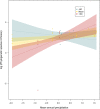Root pathogen diversity and composition varies with climate in undisturbed grasslands, but less so in anthropogenically disturbed grasslands
- PMID: 32958849
- PMCID: PMC7852655
- DOI: 10.1038/s41396-020-00783-z
Root pathogen diversity and composition varies with climate in undisturbed grasslands, but less so in anthropogenically disturbed grasslands
Abstract
Soil-borne pathogens structure plant communities, shaping their diversity, and through these effects may mediate plant responses to climate change and disturbance. Little is known, however, about the environmental determinants of plant pathogen communities. Therefore, we explored the impact of climate gradients and anthropogenic disturbance on root-associated pathogens in grasslands. We examined the community structure of two pathogenic groups-fungal pathogens and oomycetes-in undisturbed and anthropogenically disturbed grasslands across a natural precipitation and temperature gradient in the Midwestern USA. In undisturbed grasslands, precipitation and temperature gradients were important predictors of pathogen community richness and composition. Oomycete richness increased with precipitation, while fungal pathogen richness depended on an interaction of precipitation and temperature, with precipitation increasing richness most with higher temperatures. Disturbance altered plant pathogen composition and precipitation and temperature had a reduced effect on pathogen richness and composition in disturbed grasslands. Because pathogens can mediate plant community diversity and structure, the sensitivity of pathogens to disturbance and climate suggests that degradation of the pathogen community may mediate loss, or limit restoration of, native plant diversity in disturbed grasslands, and may modify plant community response to climate change.
Conflict of interest statement
The authors declare that they have no conflict of interest.
Figures



Similar articles
-
Abiotic Factors and Plant Communities Shape the Distribution of Soil Pathogenic Oomycetes in Chinese Grasslands.Adv Sci (Weinh). 2025 Aug;12(32):e01994. doi: 10.1002/advs.202501994. Epub 2025 Jun 4. Adv Sci (Weinh). 2025. PMID: 40464344 Free PMC article.
-
Disturbance reduces the differentiation of mycorrhizal fungal communities in grasslands along a precipitation gradient.Ecol Appl. 2018 Apr;28(3):736-748. doi: 10.1002/eap.1681. Epub 2018 Mar 5. Ecol Appl. 2018. PMID: 29314434
-
Contrasting relationships between plant-soil microbial diversity are driven by geographic and experimental precipitation changes.Sci Total Environ. 2023 Feb 25;861:160654. doi: 10.1016/j.scitotenv.2022.160654. Epub 2022 Dec 5. Sci Total Environ. 2023. PMID: 36473666
-
Fungal Pathogens in Grasslands.Front Cell Infect Microbiol. 2021 Aug 9;11:695087. doi: 10.3389/fcimb.2021.695087. eCollection 2021. Front Cell Infect Microbiol. 2021. PMID: 34434901 Free PMC article. Review.
-
Resilience and restoration of tropical and subtropical grasslands, savannas, and grassy woodlands.Biol Rev Camb Philos Soc. 2019 Apr;94(2):590-609. doi: 10.1111/brv.12470. Epub 2018 Sep 24. Biol Rev Camb Philos Soc. 2019. PMID: 30251329 Review.
Cited by
-
Soil Fungal Pathogens in Pinus pinaster Mature Reforestation: Silvicultural Treatments Effects.Pathogens. 2024 Jul 30;13(8):637. doi: 10.3390/pathogens13080637. Pathogens. 2024. PMID: 39204238 Free PMC article.
-
Disease resistance gene count increases with rainfall in Silphium integrifolium.Ecol Evol. 2024 Sep 3;14(9):e11143. doi: 10.1002/ece3.11143. eCollection 2024 Sep. Ecol Evol. 2024. PMID: 39234161 Free PMC article.
-
The interaction of climate, plant, and soil factors drives putative soil fungal pathogen diversity and community structure in dry grasslands.Environ Microbiol Rep. 2024 Feb;16(1):e13223. doi: 10.1111/1758-2229.13223. Epub 2023 Dec 20. Environ Microbiol Rep. 2024. PMID: 38124298 Free PMC article.
-
The influence of precipitation timing and amount on soil microbial community in a temperate desert ecosystem.Front Microbiol. 2023 Sep 7;14:1249036. doi: 10.3389/fmicb.2023.1249036. eCollection 2023. Front Microbiol. 2023. PMID: 37744930 Free PMC article.
-
Abiotic Factors and Plant Communities Shape the Distribution of Soil Pathogenic Oomycetes in Chinese Grasslands.Adv Sci (Weinh). 2025 Aug;12(32):e01994. doi: 10.1002/advs.202501994. Epub 2025 Jun 4. Adv Sci (Weinh). 2025. PMID: 40464344 Free PMC article.
References
-
- Mordecai EA. Pathogen impacts on plant communities: unifying theory, concepts, and empirical work. Ecol Monogr. 2011;81:429–41.
-
- Bever JD, Mangan SA, Alexander HM. Maintenance of plant species diversity by pathogens. Annu Rev Ecol Evol Syst. 2015;46:305–25.
-
- van der Heijden MG, Bardgett RD, van Straalen NM. The unseen majority: soil microbes as drivers of plant diversity and procductivity in terrestrial ecosystems. Ecol Lett. 2008;11:296–310. - PubMed
-
- Mangan SA, Schnitzer SA, Herre EA, Mack KM, Valencia MC, Sanchez EI, et al. Negative plant-soil feedback predicts tree-species relative abundance in a tropical forest. Nature. 2010;466:752–5. - PubMed
-
- Comita LS, Muller-Landau HC, Aguilar S, Hubbell SP. Asymmetric density dependence shapes species abundances in a tropical tree community. Science. 2010;329:330–2. - PubMed

